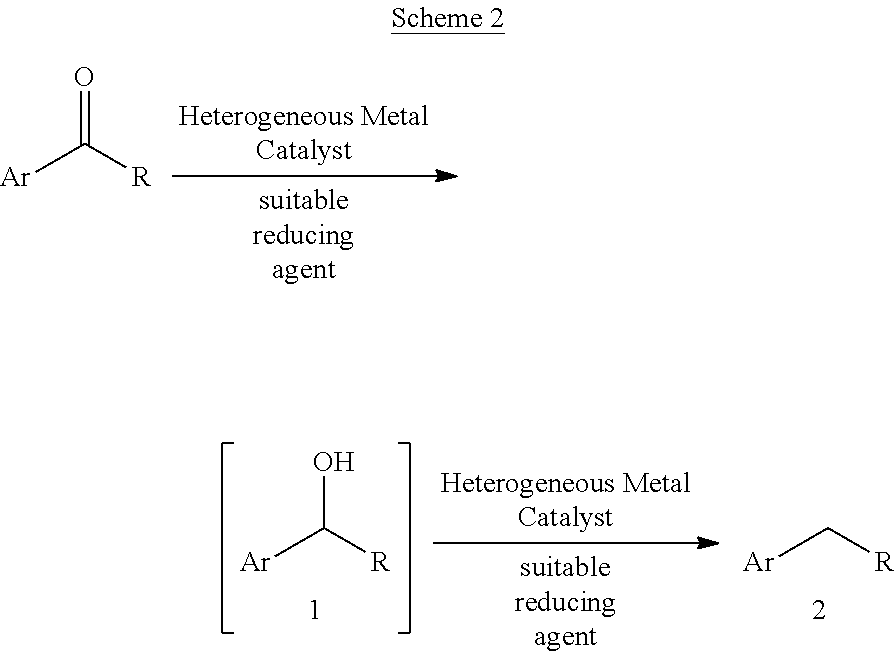A mild catalytic reduction of c-o bonds and c=o bonds using a recyclable catalyst system
a catalyst system and recycling technology, applied in the field of ecofriendly, can solve the problems of increasing the cost of the process, flammability of molecular hydrogen and metal hydrides,
- Summary
- Abstract
- Description
- Claims
- Application Information
AI Technical Summary
Benefits of technology
Problems solved by technology
Method used
Image
Examples
example 1
ion Studies (Table 1)
[0098]A microwave-vial containing a solution of 1a (0.4 mmol, 1.0 equiv.), ammonium formiate and Pd(0)-Nanocatalyst (palladium-aminopropyl-mesocellular foam (Pd(0)-AmP-MCF), 26.8 mg, 0.02 mmol, 8 wt %, 5 mol %) [1] or (palladium-aminopropyl-controlled pore glass (Pd(0)-CPG), 569 Å, 148.0 mg, 0.02 mmol, 135 μmol / g) in EtOH (2.4 mL) and H2O (0.6 mL) was stirred for 10 minutes at room temperature. Afterwards was added formic acid and the resulting mixture was stirred at room temperature for the time shown in table. NMR samples for NMR-yield were prepared by removing 0.05 mL aliquots from the reaction mixture, filtration through Celite using CDCl3 (1.5 mL) as eluent and mesitylene was used as an internal standard.
TABLE 1HCOONH4 HCO2HtemptimeConv.EntryPd catalyst(equiv.)(equiv.)(° C.)(h)(%)a 1Pd / C0.253.3 801 50[e] 2Pd(0)-AmP-MCF0.253.3 800.5 78 3Pd(0)-AmP-MCF0.253.31000.5 69 4Pd(0)-AmP-MCF0.503.3 800.5 74 5bpd(0)-AmP-MCF0.253.3 800.5 49 6cPd(0)-AmP-MCF0.253.3 80...
example 2
of Converting Alcohols to Hydrocarbon (Table 2)
[0099]
[0100]Procedure: A microwave-vial containing a solution of 1 (0.4 mmol, 1.0 equiv.), ammonium formiate (6.0 mg, 0.095 mmol, 25 mol %) and Pd(0)-Nanocatalyst (Pd(0)-AmP-MCF, 26.8 mg, 0.02 mmol, 8 wt %, 5 mol %) [2] or (Pd(0)-CPG, 569 Å, 148.0 mg, 0.02 mmol, 135 μmol / g) in EtOH (2.4 mL) and H2O (0.6 mL) was stirred for 10 minutes at room temperature. Afterwards was added formic acid (0.09 mL, 2.4 mmol, 6 equiv.) and the resulting mixture was stirred at room temperature for the time shown in table. NMR samples for NMR-yield were prepared by removing 0.05 mL aliquots from the reaction mixture, filtration through Celite using CDCl3 (1.5 mL) as eluent and mesitylene was used as an internal standard. Before the purification of the products, the crude reaction mixture was filtrated through Celite using CHCl3 (10 mL) as eluent and evaporated. The crude material was purified by silica gel flash column chromatography.
TABLE 2EntryPd catalystA...
example 3
for the Recycling of the Pd Nanoparticles (Table 3)
[0121]A microwave-vial containing a solution of 1a (61.7 mg, 0.4 mmol, 1.0 equiv.), ammonium formiate (6.0 mg, 0.095 mmol, 25 mol %) and Pd(0)-Nanocatalyst (Pd(0)-AmP-MCF, 26.8 mg, 0.02 mmol, 8 wt %, 5 mol %) [8] or (Pd(0)-CPG, 569 Å, 148.0 mg, 0.02 mmol, 135 μmol / g) in EtOH (2.4 mL) and H2O (0.6 mL) was stirred for 10 minutes at room temperature. Afterwards was added formic acid (121.6 mg, 0.1 mL, 2.64 mmol, 6.6 equiv.) and the resulting mixture was stirred at room temperature for 1 h. Next, the reaction mixture was transferred to a centrifuge-vial and EtOH (8 mL) was added and after centrifugation, the supernatant liquid was removed and the catalyst washed with EtOH (8 mL) 3 times. Afterwards the catalyst was dried under vacuum and then washed with CH2Cl2 (8 mL) three times and then dried under vacuum.
TABLE 3CycleTime (h)Conv.(%)a11>99 (95% yield)b21>9931>9941>9951>9961 98aDetermined by analysis of 1H-NMR of unpurified mixtures.b...
PUM
| Property | Measurement | Unit |
|---|---|---|
| temperature | aaaaa | aaaaa |
| temperature | aaaaa | aaaaa |
| pH | aaaaa | aaaaa |
Abstract
Description
Claims
Application Information
 Login to View More
Login to View More - R&D
- Intellectual Property
- Life Sciences
- Materials
- Tech Scout
- Unparalleled Data Quality
- Higher Quality Content
- 60% Fewer Hallucinations
Browse by: Latest US Patents, China's latest patents, Technical Efficacy Thesaurus, Application Domain, Technology Topic, Popular Technical Reports.
© 2025 PatSnap. All rights reserved.Legal|Privacy policy|Modern Slavery Act Transparency Statement|Sitemap|About US| Contact US: help@patsnap.com



